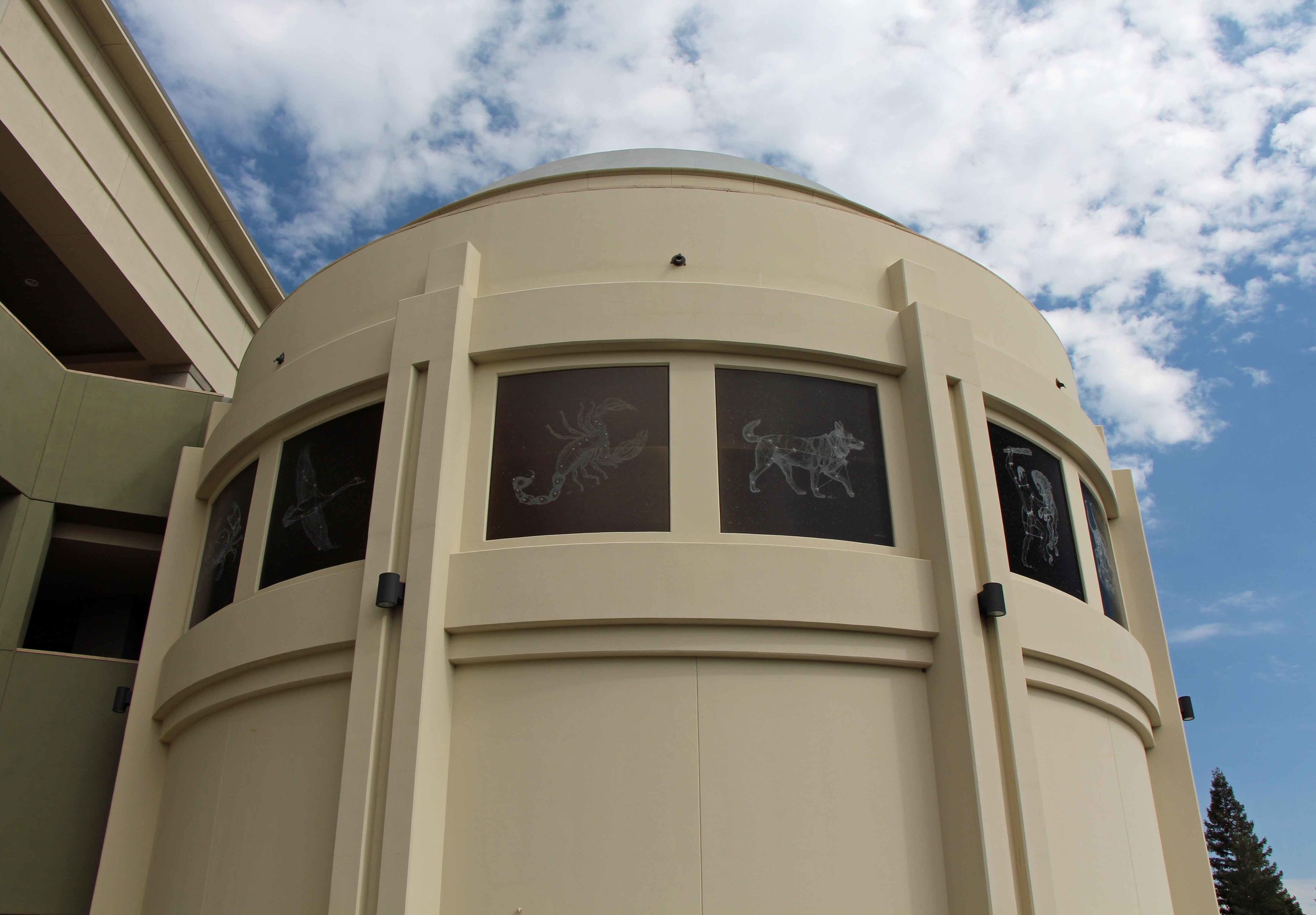MJC’s Great Valley Museum and Planetarium
Photo by Adam Blauert
What’s the best new thing within an hour’s drive of home? It’s the recently reopened Great Valley Museum and the brand new William R. Luebke Planetarium at Modesto Junior College. An impressive state-of-the-art museum about local species and habitats, it is housed in the beautiful new Science Community Center at MJC. Planetarium shows are regularly scheduled on Fridays and Saturdays.
The original Great Valley Museum closed a couple of years ago in preparation for the move to the Community Science Center. It reopened in April 2015, reborn with extensive world-class displays of local wildlife and their habitats.
Although the majority of visitors are Modesto-area elementary students, the museum’s exhibits are designed to be interesting to all ages. My wife and I learned a lot during our recent visit.
Photo by Adam Blauert
The museum’s displays meticulously recreate local habitats with every major species represented. You see the animals up close. They can’t fly or run away, so it’s much easier to observe their features than in the wild. Informative signs provide the names and interesting facts about them. Although a few displays are still being completed, the majority are finished.
The attention to detail is spectacular. The more you look, the more you notice less-visible species hiding amidst the plant life – just the way it is in nature. This is a great place to learn about the species before you go out to observe them at one of our local wildlife refuges.
Photo by Adam Blauert
The largest displays depict local wetlands. The wetlands displays are surrounded by smaller displays of birds and mammals of all sizes including elk, pronghorn, mountain lion, raptors, fish, and extinct species such as grizzly bear, gray wolf, and jaguar.
There’s a nice collection of Native American artifacts and a display about giant fossil salmon and tortoises excavated at Turlock Lake by CSU Stanislaus. The museum also offers “Science on a Sphere.” A system of four projectors displays moving images on a large globe suspended from the ceiling.
During our visit it was being used to display satellite imagery of historical global weather patterns, including El Nino events from the past few decades. The museum has an extensive list of educational programs they can project on the sphere. It’s an outstanding teaching tool for understanding our how our planet functions.
Want to learn more about the elements of the periodic table? The museum has an interactive periodic table with short video clips about each. Nearby is a large wall-mounted periodic table with physical examples of almost every element.
The second major feature of the Community Science Center is the planetarium. The night sky can be projected on the 40-foot dome to teach students about the night sky and our universe. The regularly scheduled planetarium shows are one-hour scientific programs about features of our universe.
They are projected across the entire ceiling dome – producing a far more exciting effect than a flat movie theater screen. Each Friday-Saturday there are usually three programs to choose from – each aimed at a different age range. We saw Ultimate Universe during our recent visit.
Photo by Adam Blauert
It was a visually fascinating and up-to-date overview of the universe.
The staff and volunteers are friendly, welcoming, and informative. The price is reasonable: $3/ages 4-12, $5/ages 13-54, $4/age 55 and up, or $15 for a family of up to 6 members. Planetarium shows are $4/ages 4-12, $6/ages 13-54, and $5/age 55 and up, with discounts for MJC students and staff. Parking is $2 on weekdays, free on weekends.
Current hours are Tuesday-Thursday 12-4PM and Friday-Saturday 9AM-4PM.
For more information go to http://www.mjc.edu/instruction/sme/gvm/ or call (209) 575-6196.
Photo by Adam Blauert
Group tours and school field trips can be arranged for all ages. In addition to regular exhibits, and a wide selection of planetarium and Science on a Sphere presentations, there’s a large Discovery Room for hands-on science activities.
It’s close enough to home for school and club field trips. The Nature Shop has a large selection of science-themed books and gifts, most of which focus on local wildlife and habitats.
We spent close to 3 hours at the museum and look forward to returning again soon. In addition to the indoor exhibits and the planetarium, there’s a large water fountain in front of the building with jets that spout water at various angles and heights in computer-programmed patterns.
We had as much fun watching it as a toddler who happened to be there at the same time. The programming makes the water seem playful, reminding us of the play we’ve seen demonstrated by animals such as dolphins and dogs.
Photo by Adam Blauert
The Science Community Center also houses a Foucault pendulum, a four-story DNA model, and large scale models of our universe’s planets. Sculptured mountain lions and tule elk guide the entrances.
Near the fountain, a two-ton granite sphere floats atop a water jet. Gradually spinning, you can change its direction with a surprisingly minimal amount of effort.
The outside of the planetarium is decorated with twelve large etchings on metal plates showing the stars that make up some of the best- known constellations. The stars are incorporated into images of the figures that the ancients associated with them.
Photo by Adam Blauert
Designed by MJC art professor Dr. Richard Serros, they depict the interaction of mythology, imagination, and early astronomy. The stars are represented by LED lights that are lit at night. You wouldn’t see them shine during a regular visit to the museum, but the museum hosts a “Science Night at the Museum” on the first Friday of every month during the fall and spring semesters (except January).
During these events, planetarium shows are offered, the museum’s exhibits are open, Science on a Sphere shows will be presented, and the MJC Astronomy Club offers free telescope viewings on the top level of the Science Community Center.
For more information about “Science Night,” call the museum at (209) 575-6196. If you go during the fall, winter, or spring, dress warmly so you can enjoy the telescope viewing and the museum’s outdoor exhibits.
Parking is free during these events.
The Great Valley Museum and Luebke Planetarium are part of the Community Science Center at Modesto Junior College’s West Campus, located at 2201 Blue Gum Avenue in Modesto. You can see it on the west side of Highway 99 as you drive through Modesto. To find it, exit Highway 99 at Carpenter Road/Briggsmore Avenue.
If you’re coming from Merced, turn left across the freeway on Carpenter Road. If you’re coming from the north, take the same exit, but turn right onto Carpenter. Either way, you’ll be on Carpenter for less than half a mile. From Carpenter, turn right on Blue Gum Avenue (right after you pass Collegiate Lane).
Photo by Adam Blauert
Turn right again in less than a half mile at the 4th Street stoplight. The parking lots are to the right and you should be able to spot the three-story museum building with its large planetarium dome to the left.
If you’re interested learning more about science, these additional locations are also highly recommended:
Wildlife Refuges – the ideal destination to follow a visit to the Great Valley Museum – especially exciting in the winter months when millions of migratory birds spend the winter in our valley. To combine a refuge visit with your trip to the Great Valley Museum, the closest refuge location is the viewing platform on Beckwith Road, about eight miles west of Modesto. For directions and more information, go to: http://www.fws.gov/refuges/profiles/index.cfm?id=81654. More extensive viewing opportunities are located at the Merced National Wildlife Refuge (birds) on Sandy Mush Road and the San Luis National Wildlife Refuge (birds and tule elk) on Wolfsen Road, north of Los Banos. For more information about these refuges, go to Merced County Events page about wildlife refuges.
Madera Fossil Discovery Center – a great place to learn about extinct creatures that lived in our Valley 800,000 years ago. For more information go to Fossil Discovery Center.
Applegate Zoo – the place to see local wildlife up close – including mountain lion, bear, bobcat, fox, and deer. There’s also a petting zoo and gift shop. For more information go to Merced County Events about Applegate Zoo.









Adam Blauert, a high school teacher and avid outdoors enthusiast, has dedicated the majority of his life to Merced County. His passions include fishing, backpacking, delving into local history, and exploring the wonders of the western states.